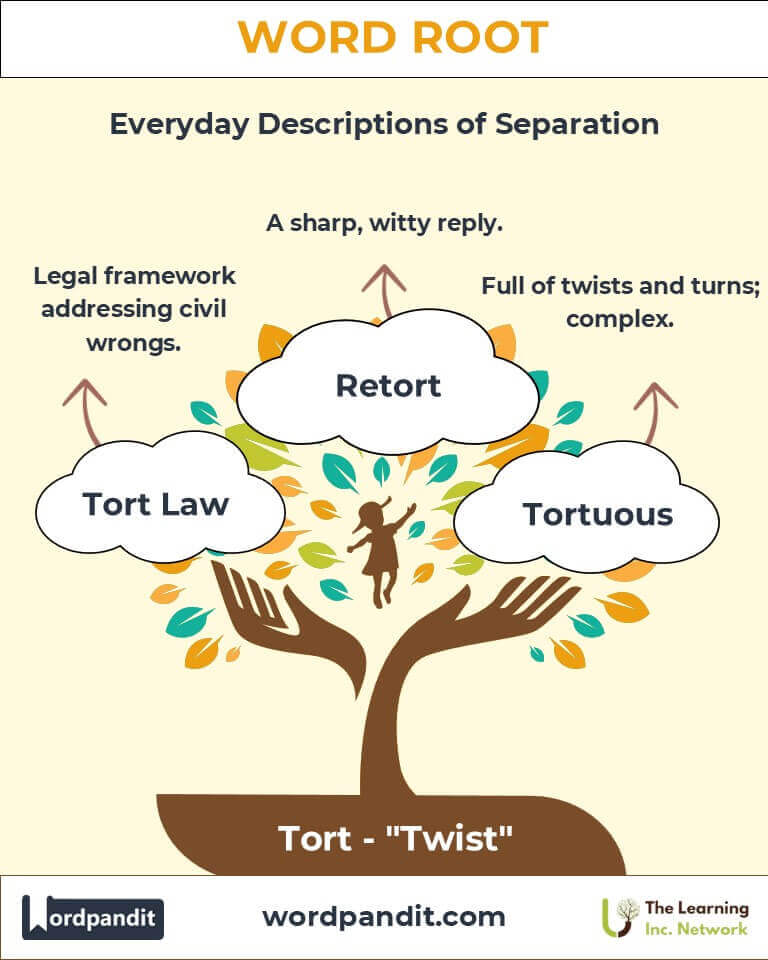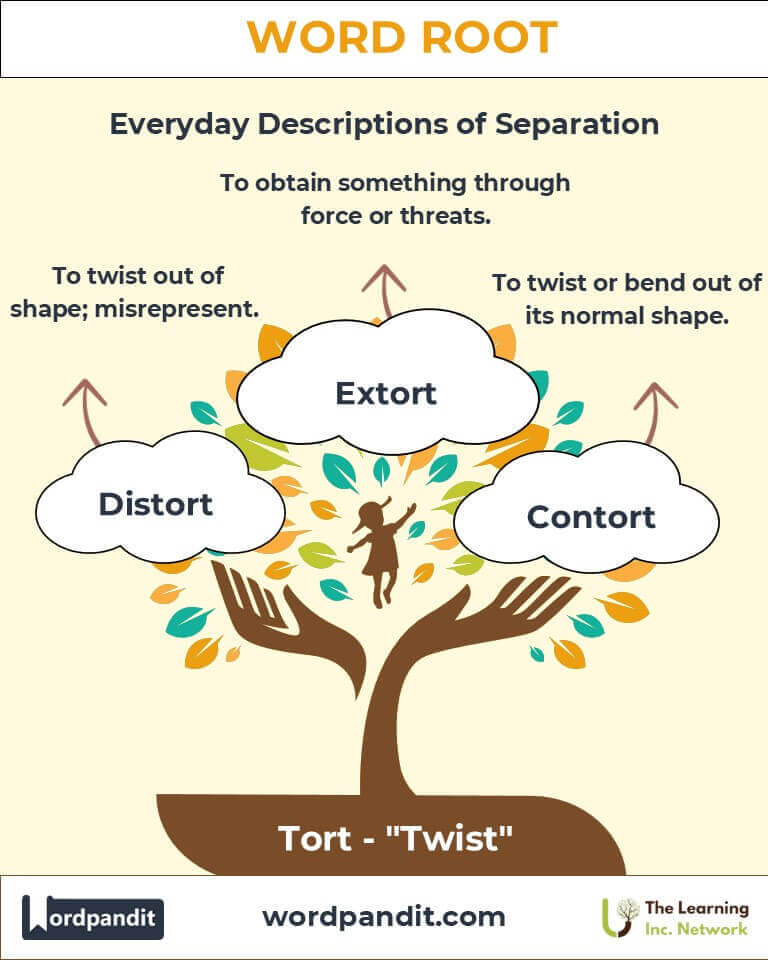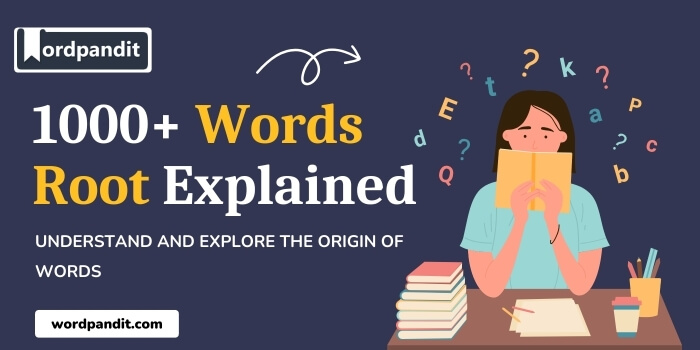Tort: The Power of Twist in Language and Expression
Byline: Discover the intriguing journey of the word root "tort," derived from Latin, meaning "twist." From familiar terms like "torture" and "distort" to specialized uses in law and art, "tort" underscores transformation and manipulation, both literal and metaphorical.

Table of Contents
- Introduction: The Essence of "Tort"
- Etymology and Historical Journey
- Mnemonic: Unlocking the Power of "Tort"
- Common Tort-Related Terms
- Tort Through Time
- Tort in Specialized Fields
- Illustrative Story: "Tort" in Action
- Cultural Significance of the "Tort" Root
- The Tort Family Tree
- FAQs About the Tort Word Root
- Test Your Knowledge: Geo Word Root Quiz
- Conclusion: The Living Legacy of "Tort"
1. Introduction: The Essence of "Tort"
When you hear the word "tort," what comes to mind? Perhaps a legal case or the wrenching imagery of "torture." The root "tort," pronounced as tort, stems from Latin torquere, meaning "to twist." This versatile root twists its way into words describing manipulation, bending, or misrepresentation. Found in disciplines ranging from law to art, "tort" conveys ideas of distortion, complexity, and conflict.

2. Etymology and Historical Journey
The root "tort" originates from the Latin verb torquere, meaning "to twist or turn." Over time, it entered Old French as torcion, symbolizing physical or figurative twisting. By the 14th century, "tort" took on legal connotations, referring to civil wrongs or actions causing harm. Its linguistic journey highlights its transformation across languages and applications.
3. Mnemonic: Unlocking the Power of "Tort"
Picture a rope tightly twisted into a knot. Imagine untwisting it reveals hidden meanings and connections. Use this mnemonic:
"Tort twists truth, turning tales into trials."
4. Common Tort-Related Terms
- Torture (tor-cher):
- Definition: Infliction of severe pain or suffering.
- Example: "The movie portrayed the cruel torture of prisoners during war."
- Distort (dis-tort):
- Definition: To twist out of shape; misrepresent.
- Example: "The funhouse mirrors distort reflections humorously."
- Contort (kon-tort):
- Definition: To twist or bend out of its normal shape.
- Example: "Her face contorted in pain as she twisted her ankle."
- Retort (ree-tort):
- Definition: A sharp, witty reply.
- Example: "His clever retort silenced the debate."
- Tortuous (tor-choo-uhs):
- Definition: Full of twists and turns; complex.
- Example: "The tortuous mountain roads were both thrilling and dangerous."
- Extort (eks-tort):
- Definition: To obtain something through force or threats.
- Example: "The gang tried to extort money from local businesses."
5. Tort Through Time
- Torture: Originally used to describe physical pain, it later expanded metaphorically to describe emotional suffering.
- Tort Law: In medieval times, "tort" entered legal lexicons, representing wrongs or injuries outside of criminal law.
6. Tort in Specialized Fields
- Law:
- Tort Law: Addresses civil wrongs, offering remedies for harm caused by negligence or intentional acts.
Example: "Tort law ensures victims receive compensation for personal injury."
- Tort Law: Addresses civil wrongs, offering remedies for harm caused by negligence or intentional acts.
- Art:
- Distortion: Used in surrealism to represent altered realities.
Example: "Artists often distort perspectives to evoke deeper emotions."
- Distortion: Used in surrealism to represent altered realities.
- Anatomy:
- Torsion: Refers to the twisting of body parts, such as intestines or muscles.
Example: "Torsion of the stomach is a medical emergency in animals."
- Torsion: Refers to the twisting of body parts, such as intestines or muscles.
7. Illustrative Story: "Tort" in Action
In a small town, Sarah, an artist, struggled to depict emotions through her abstract paintings. She used contorted shapes and distorted colors to illustrate human suffering. One day, a lawyer visiting her gallery marveled at the connections between her work and his tort cases, remarking how both art and law untangle the complexities of human conflict. Their collaboration led to a charity project—art that funded legal aid for the underprivileged.
8. Cultural Significance of the "Tort" Root
The root "tort" symbolizes life's inherent complexities. From literary descriptions of twisted fates to legal frameworks resolving civil disputes, it reflects humanity’s constant navigation through challenges and misunderstandings. Its presence in art, literature, and jurisprudence highlights its cultural depth.

9. The Tort Family Tree
- Torqu- (Latin: twist):
- Torque: A force causing rotation.
- Tors- (Latin: twist):
- Torsion: Twisting of an object or body part.
- Ver- (Latin: turn):
- Versatile: Able to turn easily between tasks.

10. FAQs About " Tort "
Q: What does the root "tort" mean?
A: The root "tort" means "twist," originating from the Latin word torquere. It can refer to physical twisting or metaphorical concepts like distortion, complexity, or manipulation.
Q: What is tort law?
A: Tort law is a branch of civil law that deals with wrongful acts causing harm or injury to individuals. It provides remedies like compensation for damages caused by negligence, intentional harm, or strict liability.
Q: What is the difference between "tortuous" and "torturous"?
A: "Tortuous" describes something winding, complicated, or indirect, such as a "tortuous road" full of twists and turns. In contrast, "torturous" relates to torture or extreme pain and suffering, whether physical or emotional.
Q: How is "distort" related to "tort"?
A: "Distort" combines the prefix dis- (meaning apart or away) with tort, meaning to twist. It signifies twisting something out of its original shape or misrepresenting the truth.
Q: Is "tort" used only in negative contexts?
A: While many "tort"-related terms have negative connotations, such as "torture" or "extort," others, like "retort," highlight wit and intelligence, and "torsion" is neutral and technical, used in physics and anatomy.
11. Test Your Knowledge: " Tort " Mastery Quiz
1. What does the root "tort" signify?
2. What is a tortuous road?
3. Which word involves obtaining through threats?
4. How does "tort" relate to art?
5. What does "retort" mean?
12. Conclusion: The Living Legacy of "Tort"
The root "tort" twists through language, law, and culture, illustrating the complexities of human expression and interaction. From its literal origins to its metaphorical expansions, "tort" continues to shape how we understand conflict, creativity, and resolution. Let it inspire you to untangle challenges and appreciate the beauty of complexity.












